Figures & data
Figure 1 Screen capture of one of the eleven thematic pages from the Perspectives in Maritime Archaeology online course. ThingLink was used for the technical execution of the online course. Clickable buttons with text, links, and documents can be added onto the images and videos. The visual appearance of the course platform resembles a board game or the itinerary of a ship (photo: Marko Mikael Marila).

Figure 2 Breakdown of the course’s themes based on the percentage of participants who found a particular theme especially enjoyable. The participants were allowed to choose one or more theme. ‘Worldviews’ was selected by 26 students as particularly stimulating.

Figure 3 Breakdown of the course’s thematic sections that left the students feeling uninspired or indifferent. The participants were allowed to choose one or more theme. ‘Maritime archaeology and contemporary art’ stands out as a topic that divided the students into two distinct groups (see ). Importantly, more than half of the participants felt that none of the topics left them feeling indifferent.

